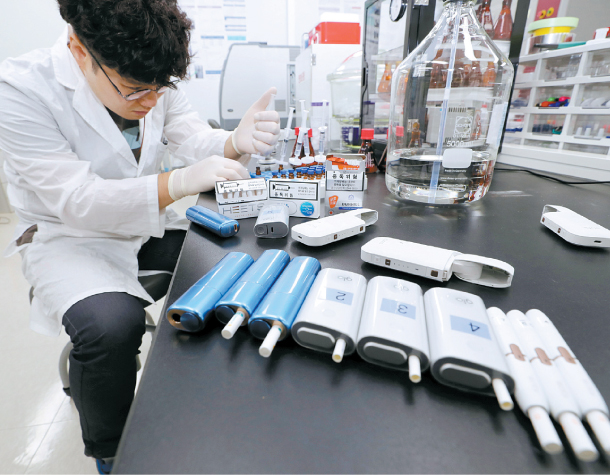Heat-not-burn ciggies aren’t safe, says gov’t

A researcher at the Ministry of Food and Drug Safety demonstrates the analysis of substances produced from heat-not-burn cigarettes at a lab in Cheongju, North Chungcheong, on Thursday. [YONHAP]
Tobacco makers disagreed and claimed the results will only confuse smokers.
On Thursday, the Ministry of Food and Drug Safety announced the results of an 11-month investigation of the safety of heat-not-burn cigarettes.
There are currently three heat-not-burn cigarettes being sold in Korea: Philip Morris Korea’s IQOS, British American Tobacco’s glo and KT&G’s lil. While ordinary cigarettes burn tobacco leaves to make smoke, heat-not-burn cigarettes produce vapor by steadily heating the leaves at a lower temperature.
Manufacturers have promoted the product as a less harmful alternative to conventional cigarettes, a claim the government refuted on Thursday.
The smoke produced from the three brands of heat-not-burn cigarettes was analyzed to measure nicotine, tar and nine harmful substances the World Health Organization has criticized in cigarettes.
Tar collectively refers to substances produced during combustion, except for water and nicotine. The government test results showed that the three heat-not-burn products produced levels of tar between 4.8 and 9.3 milligrams. IQOS and lil produced more tar than some of the most popular ordinary cigarettes, which normally produce less than 8 milligrams.
The nicotine content of the heat-not-burn cigarettes was between 0.1 and 0.5 milligrams. Ordinary cigarettes produce between 0.01 and 0.7 milligrams.
Regarding the nine other harmful substances, heat-not-burn cigarettes produced levels between zero to 30 percent of the amount produced by ordinary cigarettes.
“Two heat-not-burn cigarettes produced more tar than conventional cigarettes,” said a government statement, adding that they may contain harmful substances not found in conventional cigarettes.
It also said that heat-not-burn cigarettes can’t be used to help quit smoking if they produce similar levels of nicotine, an addictive substance, and that heat-not-burn cigarettes can cause diseases like cancer.
“We plan to effectively use the test results to supervise cigarette products and establish antismoking policies,” the government said in its statement.
Heat-not-burn manufacturers rebutted the claims, sticking to the stance that the products are much safer than ordinary cigarettes. Their main point was that it is wrong to deem heat-not-burn cigarettes as dangerous based on the total amount of tar.
“Tar itself is not a harmful substance; it’s a term referring to all substances in the cigarette smoke aside from nicotine and water,” Philip Morris Korea said in a statement.
“Vapor from heat-not-burn cigarettes and smoke from combustible cigarettes are fundamentally different,” it continued. “Therefore the comparison should be based not simply on the total amount of tar, but specifically the content of harmful substances.”
Philip Morris Korea and British American Tobacco Korea (BAT) both said that in terms of harmful substances, the government’s report aligns with their research as the nine substances defined as harmful by the WHO had all been detected in much smaller amounts than ordinary cigarettes.
“We can’t define all of the substances [that constitute vapor or smoke], which is why the WHO designated certain substances [to regulate] that are the most harmful,” said a BAT Korea spokesman. “They are harmful substances defined by credible global institutes and that’s what we should judge health effects upon.”
Regarding the government’s criticism of nicotine content, both companies said that they never said heat-not-burn cigarettes were nicotine-free.
BY SONG KYOUNG-SON [song.kyoungson@joongang.co.kr]










with the Korea JoongAng Daily
To write comments, please log in to one of the accounts.
Standards Board Policy (0/250자)